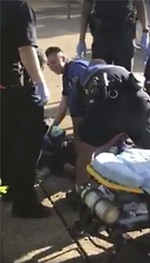The Problem With K2, Downtown Austin’s Most Dangerous Drug
APD cannot depend on big busts alone to solve the problem
By Nina Hernandez, Fri., March 16, 2018

Last spring, just before South by Southwest, the city's public safety entities began to notice a disconcerting surge in bad reactions to the drug K2. That winter, the substance – tobacco or another plant matter that gets sprayed down with a synthetic cannabinoid – had been causing masses of people to get sick. In a cycle now familiar to those who live and work Downtown, the cases slowed down for a few months before jumping back up to its two-year peak.
K2, which looks like marijuana but gives users a high that's more akin to smoking Drano, has been around for years, but by last March had grown into something more ceaseless; Downtown paramedics and firefighters were responding to as many as 10 related calls per day. Austin Police arrested street dealer after street dealer, and yet medics with Austin-Travis County EMS continued to drown in the deluge of new calls.
"You saw it going up," said Justin Newsom, an assistant chief with APD who at the time was commander of the department's Downtown sector. "But we had South by Southwest to deal with, and that's about all we can handle for the time that it's here." APD estimates it responded to around 700 K2 calls during those spring months.
Reactions to K2 vary by the chemical compounds providers used to fertilize their flammable substance. It can draw people into catatonic states, and make them either stand rigid in place like zombies or drop to the ground with no warning. But effects can also be more violent, and cause seizures, elevated blood pressure, and aggression.
"You also have to consider, what's the general health of the person?" reminded Captain Darren Noak, a public information officer with ATCEMS. "What's their medical history? What medications are they on? What medications are they supposed to be taking that they aren't taking?" K2 has been banned in Texas since 2010, but it has remained popular due to its abundance, low cost, and the fact that, unlike marijuana, it doesn't show up on urine tests. And until the state changed the law in 2016 to account for chemical developments, manufacturers had figured out a way to consistently produce new strains, staying one step ahead of law enforcement. ATCEMS started tracking reactions back in 2012, and estimates its medics have responded to 7,000 calls since then. The department says it didn't develop a reliable way to track related cases in real time until last year.
Most of those cases have occurred within the city's Downtown area, particularly along the Red River district that includes both the Austin Resource Center for the Homeless and the bustling entertainment district that borders the ARCH to its south and east. Last February, Chronicle Music columnist Kevin Curtin reported several members of that community at their wit's end with the way K2 was wreaking havoc on the area. Barracuda co-owner Jason McNeely reported seeing dealers dole out K2 (and other drugs) just beyond his Seventh Street club at all hours of the day, leaving people incapacitated on street corners, sidewalks, alleyways, or wherever they happened to be when the effects took hold from a fateful puff. For those living unsheltered within the area and struggling to get back on their feet, the constant chaos proved a disruption to their cause.
"It's an overpowering drug," said Quinn, a man I met Downtown last Wednesday who stays at the Salvation Army and says he regularly sleeps next to K2 users. "And it takes over your self-conscious and your self-control."
Enough Is Enough
Here is how the story goes: It's the middle of an afternoon, and a man walks out of Brackenridge Hospital and steps out onto the sidewalk. Moments before, he'd been in the emergency room being treated for a bad reaction to K2. And yet just as soon as he said goodbye to the hospital staff, he was sparking up again, naturally with the same results: The man was back inside the emergency room within minutes.
Though that's one of the more dramatic tales you'll hear from paramedics who work Downtown, it's not far off from what they see each day. And for the city's three public safety entities, the constant deluge proved a strain on coveted resources. Medics in particular reported the exhaustion that comes from responding to people in distress and transporting them to the hospital only to see that same person just hours later trembling from more K2. "So it was because of that quick turnaround, because of the frustration we were seeing, because we were hearing from the staff on the streets, 'What can we do?' said EMS Division Chief Eric Jakubauskas. "We started addressing it through PIO and trying to get it to the front of the newspapers, on the top of what people are talking about."
ATCEMS had been working on this problem for some time. The department saw its first big reaction spikes in the fall of 2014. But until recently that data was painstakingly tabulated by medics working in communications.
That yeoman's work didn't go unnoticed in public safety circles across the country. In the fall of 2015, Noak and PIO Commander Mike Benavides presented at a federal Dangerous Drug Task Force that included Customs & Border Protection, the Drug Enforcement Agency, Houston's Port Authority, and representatives from local law enforcement agencies from Round Rock back to Houston. "We illustrated with our presentation that even though our numbers are such here, this is a nationwide epidemic, and in some parts it's even worse than what we're experiencing," Benavides said. "So while we are seeing some very startling numbers here, this has obviously been on the map for a while, and it's barely hitting us locally and in the state. It's barely striking us to the extent that it's becoming an obvious hazard to public health and public safety."
That sentiment was correct; the problem would only intensify. Monthly response call totals began to climb again in May of 2016, eventually reaching its peak one year later at 457 total calls. It was around that time that Benavides recalls Chief Ernie Rodriguez saying, "Enough is enough." He worked with Benavides and crew to figure out how to dial up their efforts, beginning with the department's FirstWatch tracking system to track K2 calls in real time. The old process, in which medics would identify a K2 call, relay it to a communications officer, who would then add it to their tabulation to send out to the rest of the agency, would be no more. Tracking in real time gave the department a new way to look at trends, target resources, and – perhaps most importantly – communicate with the media and get the word out about new spikes as well as the general dangers of K2.
"As a community, the public safety community, we will be more prepared because we've gone through the exercise, for lack of a better term," Benavides said. "We, with our reporting system and our tracking system, are better prepared: If we see that spike, we're going to be notified of it quicker, and then we're going to be able to start targeting our messaging quicker, which will alert the local media. And so it starts the chain of events again. The goal, though, is to prevent it from getting to the point where it starts up again."
One persistent problem Benavides and Noak note is the lack of state-level leadership. The state does virtually nothing to keep track of these cases, and it shows in their recordkeeping. Responding to a request for records of statewide K2 reactions, the Department of Health & Human Services supplied a list of synthetic cannabinoid exposures reported to the Texas Poison Center Network – the first place the homeless victims of K2 are likely to report. That network has noted just 4,000 such cases, only a fraction of the 7,000 reported cases here in Austin, a figure that certainly excludes cases that were never determined to be caused by exposure to K2.

Downtown Crackdown
Last fall while Newsom was down in Houston helping with rescues after Harvey, he noticed first responders attending to K2 cases. He took it as another sign that the drug won't be going anywhere in Austin anytime soon.
APD has known that large supplies of K2 come through the ports in Houston, and its narcotics unit has doggedly pursued the dealers coming into town on major highways. Those efforts have led to some results: In November, after learning that a group had been busy moving massive amounts of K2 around the city, the department's Organized Crime Division coordinated with the Houston Police Department's Kush Task Force to haul in 164 pounds of product. In that one bust, police removed more than 200,000 doses from the market – a street value of $1.1 million. That's another reason K2 has remained as popular and accessible as it is: While it's cheap on the street (costing $5 or so per joint), it's even more cheap to produce. The profit margin continues to reward dealers who fall through law enforcement's hands.
But APD cannot depend on big busts alone to stop the problem. And so last April, City Council passed a resolution to direct resources toward an education campaign that would help alert the community to K2's risks. APD also invested heavily in an increased patrol presence around Red River. Five officers and a sergeant were tasked with staying in the area to not only act as a deterrent for dealers, but also engage with the homeless community on the issue. "And all they were to do was stay in the core of Downtown and around the ARCH and do nothing but address K2 issues," said Newsom. "Take the calls if there's overdoses, but also be proactive and visible so people would see them and move along if they were so inclined to sell it." While that was going on, the Organized Crime Division had its team of eight narcotics officers (and a sergeant) specifically targeting K2 dealers. Newsom helped with the broader education campaign, speaking to groups at the ARCH and answering questions about K2.
Unfortunately, that pilot program was only temporary – and also quite costly. The extra ARCH officers alone cost APD $170,000 per month, and didn't seem to serve as the permanent deterrent the city hoped for. "Are we ever going to have another spike?" Newsom asked rhetorically during a conversation last September. "If I had to bet money, I would say yes. Because you can't sustain the same level of enforcement and direction on one particular drug in one particular location forever. Our resources are limited. We have other drugs. The same narcotics unit that put all that effort into working down at the ARCH, there's other neighborhoods with drug problems that they need to get to at some point. We can't maintain the sergeant and [five] officers on overtime."
Lack of funding isn't just a problem for APD. Austin Public Health still needs an epidemiologist to reckon with the impact of K2 throughout the city; the problem is not simply confined to the Downtown area. But it would cost an estimated $100,000 to staff that position, and there's currently no funding in the budget to do so. The service providers around the area could also benefit from K2 response training (at a $10,000 clip), a true public awareness campaign (add another $80,000), and three dedicated peer specialists to work with people at the street level at an $87,000 clip.
"It's Back"
K2 calls did go down for a time after reaching that 457-call apex last April. The number fell to 168 in May and continued to decline for the next several months. But as expected, K2 has hardly gone away, a truth that proved quite evident when I revisited the area last week. "It's back," McNeely reported grimly as he prepared for another South by Southwest.
While there hasn't been anywhere near the number of reactions that there were last spring, McNeely has noticed a heightened amount of activity since January. "There's like a new collective of drug dealers," he said. "They look like young teenagers. They basically walk around Red River and the ARCH. They kind of run the hood. They're very predatorial. It's a living nightmare."
McNeely said APD's enforcement measures functioned the way a cork would plug a dam. "They'll do a pilot program where they have adequate security, and then they clean it up – they prove they can do it – and then they pull the officers." He said ultimately the area needs more long-term security. When police were stationed around the ARCH, more violent dealers moved over to 10th Street. Once the police exhaust their overtime resources, there's little stopping those bad actors from returning to prey on the homeless community. "The people who need these services the most are jeopardized more than anybody else," McNeely said.
Newsom agreed with McNeely's assessment that permanent officers would do a great deal to improve the quality of life for everyone who lives and works around Red River. But APD doesn't have enough officers to staff that area for long – hence the periodic crackdowns producing dramatic results – so those hours have to be filled through overtime, making the fight against K2 more or less a financial issue: If City Council ponied up the funds, APD could find officers to take that position. Like so many issues within the city, it's a matter of prioritizing, one of the reasons EMS has worked to get these numbers and stories into the hands of local media.
"And we absolutely would [provide that staffing]," Newsom told me. "If I had the overtime money, I have the cops that would love to work it. I could fill it every single day if I had the money to do it."
Got something to say on the subject? Send a letter to the editor.













